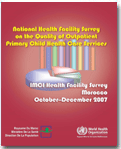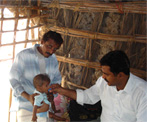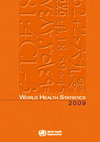National Health Facility Survey on the Quality of Outpatient Primary Child Health Care Services", Morocco, October – December 2007
 The report on the “National Health Facility Survey on the Quality of Outpatient Primary Child Health Care Services" (IMCI Health facility Survey) conducted in Morocco at the end of 2007 is now available on this website, together with the survey instruments and adapted guidelines. Conducted after seven years of expanded implementation of the Integrated Management of Child Health (IMCI) strategy in the country, the survey had the main objective to collect quantitative and qualitative information to assess the quality of outpatient health care services, including both the clinical and health system support components, provided by IMCI-trained staff to sick children below 5 years old at health centres. The survey report provides a wealth of information, critically analyzed, useful to inform planning. It contains a set of few recommendations to improve the quality of primary child care services in the country. The recommendations concern the utilization of primary health care services, improving the policy on medicines to provide equitable access to medicines for children and developing a national child health policy and scaling up IMCI implementation as part of the commitment to Millennium Development Goal 4 on reducing child mortality. The role of IMCI pre-service education is also highlighted.
The report on the “National Health Facility Survey on the Quality of Outpatient Primary Child Health Care Services" (IMCI Health facility Survey) conducted in Morocco at the end of 2007 is now available on this website, together with the survey instruments and adapted guidelines. Conducted after seven years of expanded implementation of the Integrated Management of Child Health (IMCI) strategy in the country, the survey had the main objective to collect quantitative and qualitative information to assess the quality of outpatient health care services, including both the clinical and health system support components, provided by IMCI-trained staff to sick children below 5 years old at health centres. The survey report provides a wealth of information, critically analyzed, useful to inform planning. It contains a set of few recommendations to improve the quality of primary child care services in the country. The recommendations concern the utilization of primary health care services, improving the policy on medicines to provide equitable access to medicines for children and developing a national child health policy and scaling up IMCI implementation as part of the commitment to Millennium Development Goal 4 on reducing child mortality. The role of IMCI pre-service education is also highlighted.
Yemen accelerates IMCI implementation
 The Ministry of Public Health and Population provided a big boost to IMCI implementation in 2008, introducing the strategy in 54 new districts and 653 health facilities, thus reaching in total more than half of PHC facilities in the country. This is the highest IMCI implementation level per year ever accomplished in Yemen since the IMCI strategy was pilot-tested in 3 districts in the country in 2002. The number of PHC mobile teams, including IMCI care and established in 2007 on a trial basis to increase access of underserved populations to quality health services, also increased to 670 in 64 districts. While under-five mortality remains high, data recently released by WHO suggest that the under-five mortality rate has decreased by 42% between 1990 and 2007. Infectious diseases such as pneumonia and diarrhoeal diseases remain leading causes of death in young children in Yemen: accelerating the implementation of existing cost-effective interventions under the IMCI strategy and introduction of IMCI into pre-service education would help the country move closer to its Millennium Development Goal 4 set for 2015 and provide more hopes to its young children.
The Ministry of Public Health and Population provided a big boost to IMCI implementation in 2008, introducing the strategy in 54 new districts and 653 health facilities, thus reaching in total more than half of PHC facilities in the country. This is the highest IMCI implementation level per year ever accomplished in Yemen since the IMCI strategy was pilot-tested in 3 districts in the country in 2002. The number of PHC mobile teams, including IMCI care and established in 2007 on a trial basis to increase access of underserved populations to quality health services, also increased to 670 in 64 districts. While under-five mortality remains high, data recently released by WHO suggest that the under-five mortality rate has decreased by 42% between 1990 and 2007. Infectious diseases such as pneumonia and diarrhoeal diseases remain leading causes of death in young children in Yemen: accelerating the implementation of existing cost-effective interventions under the IMCI strategy and introduction of IMCI into pre-service education would help the country move closer to its Millennium Development Goal 4 set for 2015 and provide more hopes to its young children.
Progress toward MDG 4 in the Eastern Mediterranean Region
 An estimated 1.2 million deaths occurred in children under-5 in the Eastern Mediterranean Region in 2007, a 26% decline from the 1990 level. Four countries (Egypt , Morocco , Oman and Tunisia) are close to achieving MDG 4, having reduced their under-5 mortality rate by 60% or more during the same period; many others are on track to achieve the goal by 2015 if current trends continue. Of concern are 6 out of 8 countries, most plagued by conflict, in which the under-5 mortality rate has decreased by less than a third in the 17-year period and remains high, namely Afghanistan, Djibouti, Iraq, Pakistan, Somalia and Sudan. Close to a million deaths occurred among under-5 children in these countries in 2007, almost 80% of all under-5 deaths in the Region. The challenge of achieving MDG 4 in these countries is substantial. Detailed information on mortality rates and trends by country, based on the World Health Statistics, WHO, 2009, is presented in tables and illustrated with graphs in the section on "Data and statistics: Under five mortality and its causes".
An estimated 1.2 million deaths occurred in children under-5 in the Eastern Mediterranean Region in 2007, a 26% decline from the 1990 level. Four countries (Egypt , Morocco , Oman and Tunisia) are close to achieving MDG 4, having reduced their under-5 mortality rate by 60% or more during the same period; many others are on track to achieve the goal by 2015 if current trends continue. Of concern are 6 out of 8 countries, most plagued by conflict, in which the under-5 mortality rate has decreased by less than a third in the 17-year period and remains high, namely Afghanistan, Djibouti, Iraq, Pakistan, Somalia and Sudan. Close to a million deaths occurred among under-5 children in these countries in 2007, almost 80% of all under-5 deaths in the Region. The challenge of achieving MDG 4 in these countries is substantial. Detailed information on mortality rates and trends by country, based on the World Health Statistics, WHO, 2009, is presented in tables and illustrated with graphs in the section on "Data and statistics: Under five mortality and its causes".


